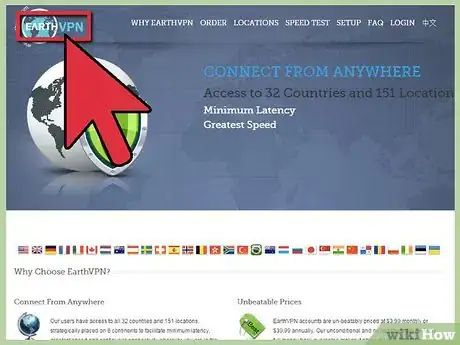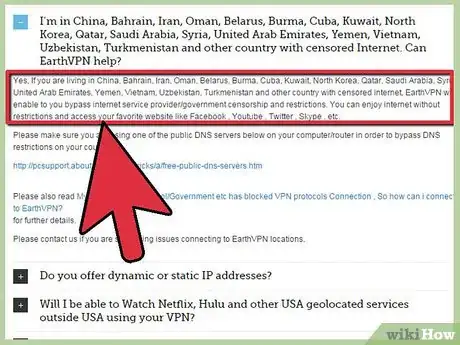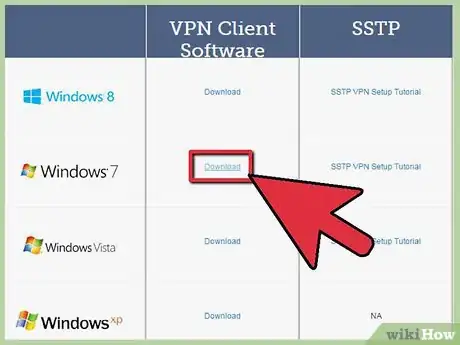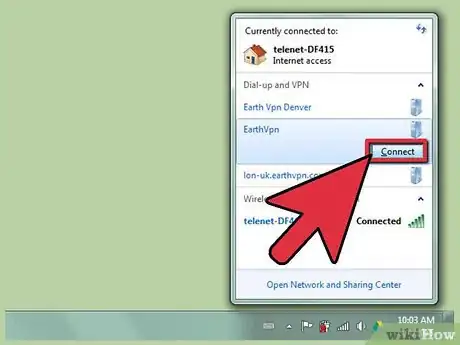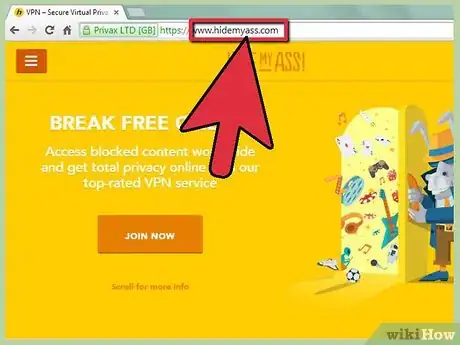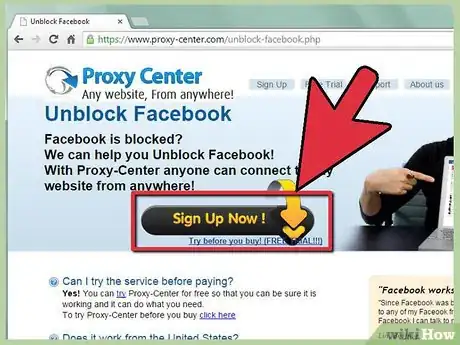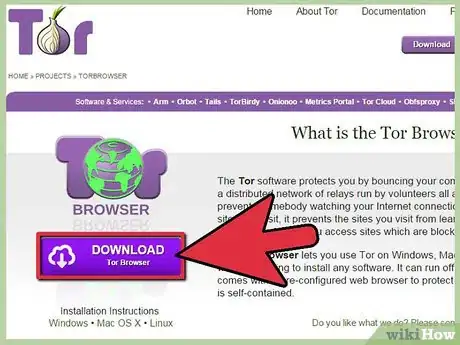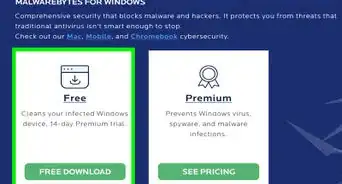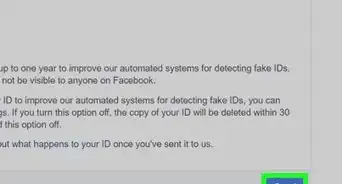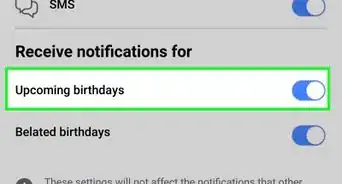X
wikiHow is a “wiki,” similar to Wikipedia, which means that many of our articles are co-written by multiple authors. To create this article, 59 people, some anonymous, worked to edit and improve it over time.
This article has been viewed 964,570 times.
Learn more...
One of the big issues travelers face when visiting China are the restrictions that the Chinese government places on internet access. Specifically, popular social sites such as Facebook, Twitter, and YouTube are blocked by the government’s firewalls, as well as various news outlets. If you want to share your travel experiences with your friends and family, follow this guide to get around the blocks and access the sites that you want to.
Steps
Method 1
Method 1 of 3:
Installing a VPN
-
1Find a VPN service that fits your needs. A VPN (Virtual Private Network) is an encrypted connection to a remote server that allow you to access the internet from behind restrictive firewalls. VPNs affect all of your internet traffic, which means Skype and other messaging services are not stuck behind the firewall either. VPNs are not free, but some offer monthly plans as opposed to yearly fee, which can be very useful for travelers.
-
2Check that the VPN you want works in China. Some of the major VPN servers have been blocked by the Chinese government and are no longer accessible. Check with the company that you are signing up with and read reviews of the service online.Advertisement
-
3Download any necessary software. Some VPN services will provide you with a VPN client that needs to be installed on your computer. Others will provide you connection information that you can enter into Windows’ or Mac’s connection manager.
- Ideally, you should download and install your VPN software before you visit China. Many of the popular VPN programs are blocked, preventing you from signing up or downloading any clients. Setting your VPN up outside of China will make it easier to contact customer support if there are any issues.
- Some VPN services offer mobile apps that you can use on your iPhone, iPad, or Android device.
-
4Connect to your VPN. Either run the client, or enter your VPN information into your operating system’s connection settings. VPN clients that are provided with the service are already pre-configured and only require you to enter your login information.
- For Windows, search for VPN on your computer and then select “Set up a virtual private network (VPN) connection” (Windows Vista/7) or “Add a VPN connection” (Windows 8). Enter your connection information. Your VPN service should have provided you with a server to connect to, as well as a username and password. Enter these into the VPN connection settings
- For Mac OS X, click the Apple menu and select System Preferences. Click on Network. Click the Add (+) button at the bottom of the list, and then select VPN from the list of options. Choose the type of VPN you are connecting to. This will be provided by your VPN service. Enter your VPN settings, including the server you are connecting to and your username and password.
- Click Connect to connect to your VPN. Most VPNs should connect automatically. If you cannot establish a connection, contact your VPN’s support service to troubleshoot the problem.
-
5Visit Facebook. Once your VPN is connected, you can visit any of the blocked sites that weren't previously accessible, as well as use any other internet-enabled programs such as Skype. You may notice a slow connection, but this is normal due to the distance between yourself and the VPN server.
Advertisement
Method 2
Method 2 of 3:
Using a Web-Based Proxy
-
1Try free proxies. A proxy is a website, often based in a different location than you, that will let you access other sites through it. So if your proxy is in the USA, and you access Facebook through it, it should be like accessing Facebook in the USA. Here is a list of free proxies for you to try. You should try them first, because why pay - but you may find they're not a great solution to access Facebook in China because:
- China keeps finding and blocking them too.
- They often don't have good enough programming to handle the technology of social media
-
2Try a secure proxy. Benefit of a proxy like this (as opposed to a VPN, which we talked about in the previous step) is that there's nothing to install on your computer - it's all web-based.
Advertisement
Method 3
Method 3 of 3:
Downloading the Tor Browser
-
1Download the Tor browser bundle. Tor is a free distributed network that keeps you anonymous while you while you are connected through the browser. Information is bounced between a large number of relays that exist all over the globe. Tor allows you to bypass any firewalls or restrictions placed on your connection. The drawback is that websites load slowly, as the data has to travel great distances to reach you.
- The Tor browser bundle is a self-contained program that does not need to be installed. You can place it onto a USB drive and plug it into any computer. The browser bundle is available for Windows, Mac, and Linux.
-
2Run the browser. The Tor browser is a modified version of Firefox, and shares a lot of interface similarities with it. When you run the browser program, a window will appear showing the status of the Tor connection. Once the connection is established, the browser will open.
- Only traffic sent through the Tor browser will be sent through the Tor network. That means that Internet Explorer, Chrome, Safari, or any other browser will not be anonymous through the Tor network while Tor is running.
-
3Check that you are connected. Once the browser window opens, you should see a page confirming that you are successfully connected to Tor. You should now be able to access sites that were previously blocked. Closing the browser window will stop Tor from running
- While data in the Tor network is encrypted, it cannot decrypt data leaving the Tor network. That means that any secure transactions that you need to make are just as vulnerable as they are on the regular internet. Only give out personal information to sites with SSL enabled. You will see HTTPS:// instead of HTTP:// and your browser address field will display a security lock.
Advertisement
Community Q&A
Did you know you can get answers researched by wikiHow Staff?
Unlock staff-researched answers by supporting wikiHow
-
QuestionWhich VPN is best for China?
 wikiHow Staff EditorThis answer was written by one of our trained team of researchers who validated it for accuracy and comprehensiveness.
wikiHow Staff EditorThis answer was written by one of our trained team of researchers who validated it for accuracy and comprehensiveness.
Staff Answer wikiHow Staff EditorStaff AnswerThe best VPN to use in China can actually change rapidly as the Chinese government implements different methods to try to target and block different VPNs. Your best bet is to look online for user reviews of VPNs they have successfully used in China and stay informed about any news about certain VPNs being blocked. For this reason, try to buy your VPN service as close as possible to the time you will be in China. The good news is that with the way the Internet is currently set up, it would be very difficult for China to block every VPN service out there.
wikiHow Staff EditorStaff AnswerThe best VPN to use in China can actually change rapidly as the Chinese government implements different methods to try to target and block different VPNs. Your best bet is to look online for user reviews of VPNs they have successfully used in China and stay informed about any news about certain VPNs being blocked. For this reason, try to buy your VPN service as close as possible to the time you will be in China. The good news is that with the way the Internet is currently set up, it would be very difficult for China to block every VPN service out there.
Advertisement
Warnings
- Bypassing the Chinese government's firewall is technically illegal and you may experience legal repercussions, though checking Facebook will most likely not cause any problems. Use this guide at your own risk.⧼thumbs_response⧽
Advertisement
About This Article
Advertisement
